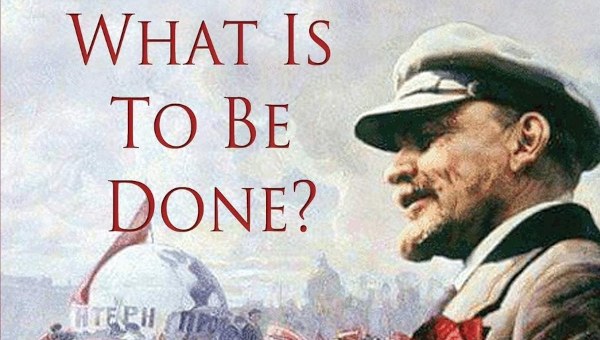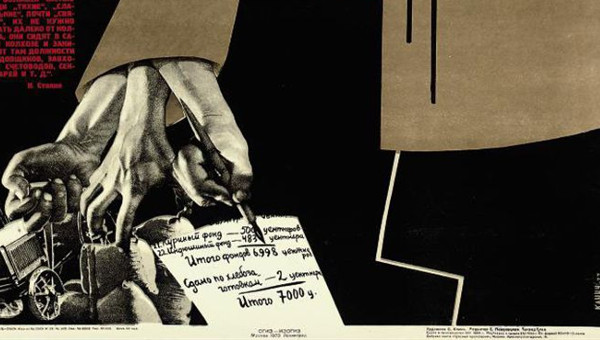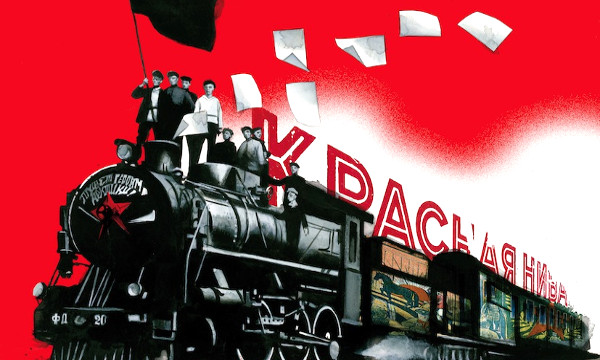Lenin’s Socialism – From the Perspective of the Future
There is a great variety of theories and discussions on the views of V. I. Lenin on socialism as well as on his revolutionary praxis, which often leads to chaos and intellectual-theoretical confusions. The present paper seeks to clarify some contested issues.1
Lenin’s theory of socialism directly derives from the views of Marx and Engels, and it is manifest in his famous work, The State and Revolution.2 Marx and Engels’ theory on socialism was so important for Lenin that he never gave it up, not even in the period of war communism, when for a short time he thought that the measures of war communism could accelerate the transition to socialism.
It is obvious that the revolutionaries, including Lenin, had to change their views after the victory of the revolution, when they had to face a changed and unforeseen political-historical situation: after a bloody civil war and a Western military intervention, the Soviet Union was alone and had to navigate under very unfavorable, “objective” circumstances.
The Key Historical Problem of Socialism in Soviet Russia
Lenin outlined the whole problem of socialism through the historical development of relations of property and production, according to which the new socialist ‘communal society’ comes into being in Russia and in the semiperiphery (Krausz 2020). Based on Marx’s theoretical tradition, Lenin’s interpretation of socialism outlined a higher form of communal ownership, direct control over workplace through the soviets of workers, the first historical ancestor of which was the Paris commune closely watched by Marx.
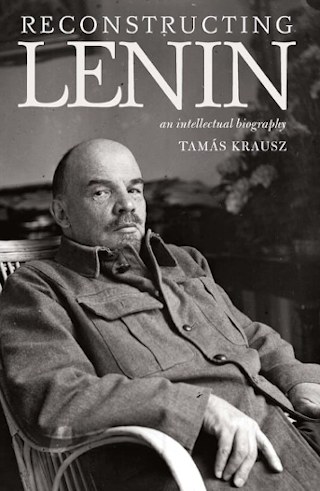
When following Marx, Lenin posited his own “three-step” concept in his State and Revolution – in which socialism, as the “lower phase” of communism, is preceded by a “transitional period” – he could not have known that the Russian Revolution would end up being isolated. As a result, theoretical socialism as a practical issue had to be put off the agenda and history moved toward the possibility of socialism in its peculiar Russian form, something he had wanted to avoid.
Thus, theoretical considerations and practical possibilities came into inevitable conflict already on the second day of the October Revolution. Taking a long term view of history, all great conflicts and contradictions have been rooted in this fact in one way or another. Lenin was conscious of the fact that “Russian backwardness” (its semi-peripheral development) facilitated the cause of the revolution, but it hindered the realization of socialism.
Most scholars agree that Soviet development has to be cut up into different periods based on economic-political criteria. The three periods following the October Revolution were the following: “market economy” that characterized the period until spring-summer 1918, the war communism of 1918–1920, and the “state capitalism” of the New Economic Policy (NEP) from March 1921 onward. These periods shaped Lenin’s thought. At this point we need a short digression on the history of socialist history.
The Conceptual Origins of Socialism
In the first half of the 1890s, Lenin, contradicting Mikhailovsky in his What the “Friends of the People” Are, rejected all dreamy visions of socialism (LCW, Vol. 1, 129–332). He made it clear that Marx’s work never painted any detailed prospects for the future: it confined itself to analyzing the present bourgeois regime, to studying the dynamic trends of development of capitalist social organization.3
Vladimir Ilyich Ulyanov, a young man from Simbirsk was 24 years old when he arrived at the clear exposition-interpretation of an alternative to capitalism; and it was a very important result especially if we consider that until now we still have no other, theoretically consistent alternative to capitalism.
Above all and very early Lenin outlined the whole problem of socialism through the historical development of ownership. In his analysis the new communal society appears in modern history after the dissolution of ancient communities. It was a higher form of communal ownership, the manifestation of new “individual property”:
“The abolition of ‘individual property,’ which since the sixteenth century has been effected in the way indicated above, is the first negation. It will be followed by a second, which bears the character of a negation of the negation, and hence of a restoration of ‘individual property,’ but in a higher form, based on common ownership of land and of the instruments of labour. Herr Marx calls this new ‘individual property’ also ‘social property,’ and in this there appears the Hegelian higher unity, in which the contradiction is supposed to be sublated (aufgehoben – a specific Hegelian term)” (LCW, Vol. 1, 169).
Therefore, socialism as a philosophical and historical possibility has its inception with the beginning of modern capitalist society in the form of primitive capital accumulation. Lenin cited Marx at length on individual property coming into existence again, which now meant the shared ownership of the tools of production (see also Krausz 2015, 313). That is, the “labour-power of all the different individuals is consciously applied as the combined labour-power of the community” on a socialist basis, as a “community of free individuals”:
“Capital becomes a fetter upon the mode of production, which has sprung up and nourished along with, and under it. Concentration of the means of production and socialisation of labour at last reach a point where they become incompatible with their capitalist integument. This integument is burst asunder. The knell of capitalist private property sounds. The expropriators are expropriated” (LCW, Vol. 1, 169 and 171–172).
In the first volume of Capital, Marx goes on like this:
“The capitalist mode of appropriation, the result of the capitalist mode of production, produces capitalist private property. This is the first negation of individual private property, as founded on the labour of the proprietor. But capitalist production begets, with the inexorability of a law of Nature, its own negation. It is the negation of negation. This does not re-establish private property for the producer, but gives him individual property based on the acquisition of the capitalist era: i.e., on cooperation and the possession in common of the land and of the means of production” (Marx, 1887 C1, Ch 32).
So Lenin interpreted the developments of modern capitalism on this theoretical basis. The Taylorist system – without its initiators knowing or wishing it – is preparing for the time when the proletariat will take over all social production and appoint its own workers’ committees for the purpose of properly distributing and rationalizing all social labour. Large-scale production, machinery, railways, telephony – all provide thousands of opportunities to cut by three-fourths the working time of the organized workers and make them four times better off than they are today. And these workers’ committees, assisted by workers’ unions, will be able to apply these principles of the rational distribution of social labour when the latter is freed from its enslavement by capital (LCW, Vol. 20, 154). Based on experiences from colonialism to the First World War, Lenin already knew that there is no such boundary or limit in the process of capitalist reproduction and in general, the process of the endless accumulation of capital, which could automatically lead to the collapse of capitalism. The 1917 October Revolution would have had no meaning if the workers and peasants had not seized the ownership of workplaces and means of production, including land, through their Soviets.
Transitional Period: From Market Economy to War Communism
Central to Lenin’s thinking after October 1917 was how to preserve the hard-won power of the soviets. In practice this was never separate from the power of his party, which saw it as the political condition upon which continuing soviet power depended. He surveyed the practical possibility of communal-socialist proletarian ends from this point of view. The contradiction, which strained the tortuous daily battles for survival and keeping to the goals, increasingly placed the discrete problems of the so-called transitional period to the forefront. Such was the mass of problems he confronted at the first congress following the October Revolution. There, he drew attention to the particularity of their revolution: the situation was misrepresented to make believe that some wanted to “introduce” socialism in Russia by decree, without considering the existing technical level, the great number of small enterprises, or the habits and wishes of the majority of the population; and, over and above, what Lenin underlined many times, the fact that 80% of the population was illiterate.
In his pamphlet, The Immediate Tasks of the Soviet Government, published as a Pravda insert on 28 April 1918, Lenin once again raised these same questions, and gradually formed his own position in light of the new situation (LCW, Vol. 27). The reason he attributed such grave importance to the difficulties caused by the “chaotic” situation was that “the military party, tempted by Russia’s momentary weakness… may gain the upper hand at any moment” in the West (LCW, Vol. 27, 237). He intended to establish a concrete economic alternative to market-dominated production in an “anarchically built capitalist society” and the “spontaneously growing and expanding national and international market” system, but which had not yet overstepped the limitations of the existing “mixed market economy” (LCW, Vol. 27, 238). True, he had already advocated “the strictest and universal accounting and control of the production and distribution of goods.” Since he spoke about “setting up an extremely intricate and delicate system of new organizational relationships,” whose realization was not merely a technical matter, it is natural that he did not envisage a complete and immediate termination of all market relations as “time is needed” to “convince the people” and “deepen the consciousness.” Lenin concluded that capitalism as a sector would have to remain standing. He said that “If we decided to continue to expropriate capital at the same rate at which we have been doing up to now, we should certainly suffer defeat,” and elsewhere that “the expropriation of the expropriators” is easier than introducing a new system. He believed that the Red Guard attacks on capital had drawn to a close and the period of “utilising bourgeois specialists by the proletarian state power” had begun (LCW, Vol. 27, 246, 248).
He even strayed from every theoretical premise and declared unequivocally that these specialists must be engaged in the service of the new regime with “high remuneration.” Lenin described this “winning over the ‘stars’ of the intelligentsia” as a “step back” and a “partial retreat” when compared with socialist equality (LCW, Vol. 27, 248–250). In the same breath – and with great prescience – he spoke of a certain and inevitable corruption of this system, the weakening of its moral fiber as a sort of natural concomitant of the “market economy.” “The corrupting influence of high salaries – both upon the Soviet authorities (especially since the revolution occurred so rapidly that it was impossible to prevent a certain number of adventurers and rogues from getting into positions of authority…) and upon the mass of the workers – is indisputable.” Yet he never found a convincing solution to this contradiction, always thinking in terms of “socialist” and “proletarian” consciousness and its persuasion, because they had not been able to establish “comprehensive control and accounting,” and had “fallen behind with the socialist reforms.” “We have introduced workers’ control as a law, but this law… is only just beginning to penetrate the minds of broad sections of the proletariat” (LCW, Vol. 27, 254).4 Essentially, the expansion of state regulation to capitalist production and turnover of goods (to the cooperatives as well) may become a fundamental question regarding financial and market conditions in the “transition leading to socialism.” In The Impending Catastrophe, he drew a clear line between state control of the bourgeoisie and the expropriation of private property that applied to the bourgeoisie, even arguing against expropriation in this specific case:
“If nationalisation of the banks is so often confused with the confiscation of private property, it is the bourgeois press which has an interest in deceiving the public. … Whoever owned fifteen rubles on a savings account would continue to be the owner of fifteen rubles after the nationalisation of the banks; and whoever had fifteen million rubles would continue after the nationalisation of the banks to have fifteen million rubles in the form of shares, bonds, bills, commercial certificates and so on” (LCW, Vol. 25, 330).
The purpose of nationalization was to oversee financial and economic processes, the actual collection of personal income taxes, etc. Lenin contrasted reactionary-bourgeois regulation to revolutionary democratic regulation, with bottom-up control, with whose limitations he soon came face-to-face. He had already stipulated that the construction of the most modern heavy industry would require state-of-the-art technical-technological progress, to apply “much of what is scientific and progressive in the Taylor system; we must make wages correspond to the total amount of goods turned out, or to the amount of work done by the railways, the water transport system, etc., etc.” Lenin thought that the feasibility of socialism depended on the successes that could be achieved in the field of “combining the Soviet power and the Soviet organization of administration with the up-to-date achievements of capitalism” (LCW, Vol. 27, 259). Apart from the cooperation and competition of economic sectors and modes of production, Lenin also spoke about the “competition of communes,” and etched out its moral driving forces more clearly than its material and economic bases. In contrast to the “allowances” made to market and financial conditions and the “bourgeois cooperatives,” the “socialist state can arise only as a network of producers’ and consumers’ communes, which conscientiously keep account of their production and consumption, economise on labour, and steadily raise the productivity of labour, thus making it possible to reduce the working day to seven, six and even fewer hours” (LCW, Vol. 27, 259).
Lenin had taken note of this, and by the spring of 1918, famine ravaged the cities. In fact, a political turn was outlined in May 1918, leading from a state-supervised mixed market economy to a dictatorship of state subsistence that swept spontaneously toward war communism. The latter, in the beginning, was determined and validated by the internal armed counterrevolution and interventionist military attacks.
NEP Versus War Communism: The State Against Capitalism for the Survival of Socialism as an Alternative
Left unexplained was that the matter does not simply rest on state power, for in war communism the state as a military force of authority, as a “deterrent to class enemies through dictatorial” power, acted as the mainspring of the economy. This had no roots in any form of Marxist theoretical tradition from Marx’s own time, and even contradicted his period’s idea of socialism. Lenin was not so naïve as to identify war communism with “complete socialism,” for he continued to believe that “as long as workers and peasants remain, socialism has not been achieved” (LCW, Vol. 30, 506). Lenin’s real theoretical mistake in 1919–1920 was that he overestimated the possibilities of socialization, of social supervision within the framework of nationalization, and underestimated the inveteracy of the market and money in a regulating role, a fact he later recognized. The “atmosphere” of the epoch, the romantic attitude toward the civil war, was also expressed in war communism’s compulsory egalitarianism.
War communism’s focus was on the consolidation of the new military-power hierarchy under civil war conditions, even though it simultaneously exacerbated the economic situation. Meanwhile, Lenin held that socialism, as a system that had reached completion, would only be composed of voluntary associations of economically productive communities organized from below. It was still a state, though, for “there remains for a time not only bourgeois law, but even the bourgeois state, without the bourgeoisie” in order to defend the “equality of labour” and public property (LCW, Vol. 25, 471). Lenin differentiated between state and social-community property even at its inception; before the introduction of war communism, he believed that the productive classes would themselves have to create socialist conditions.
Just as war communism was not the application of a theory, neither was the NEP the experiment or exercise of one. The Soviet government implemented both war communism and the NEP under pressure of concrete circumstances, requirements, and needs – without foreseeing its internal or international effects. In both cases their ideologies – the theoretical justification of the “systems” – were developed either parallel to their introduction, or as a follow-up (though war communism incorporated a number of elements from German war economic policy, and the NEP included elements from the “market economy” of the winter and spring of 1918). The NEP meant substituting militarized production – including the ration system, strict state distribution, and the compulsory appropriation of grain – with money and market conditions, reinstituting free trade and introducing taxes in kind. Often forgotten is that, at the same time, the partial reinstatement of capitalist conditions entailed a general social transformation, a restructuring of social classes and groups, and a change in their relationships.
The introduction of a market economy and “workers’ democracy” – also proved to be a contradiction that could not be bridged. Significant segments of the labouring masses became tired of the sacrifices they were called upon to make and were demanding a “loosening of the bolts,” but very few were in possession of the skills required for direct democracy. Lenin later expressed the necessity of the NEP, neatly and self-critically summarizing it at the 11th Party Congress in the spring of 1922: “We must organize things in such a way as to make possible the customary operation of capitalist economy and capitalist exchange, because this is essential for the people” (see Lenin’s speech at the 11th Congress in March 1922, LCW, Vol. 33, 279).
State Socialism Versus State Capitalism
With the ascent of the NEP, the question of socialism in Lenin’s thinking was broadened by new elements and hypotheses. He made it clear that he was unwilling to become subject to his own party’s propaganda, and he differentiated conceptually between the NEP period and socialism. The NEP came to be defined as an unpremeditated “transitional phase” within the transitional period. Lenin consciously took precautions not to make the same mistake, made during war communism, of attempting to give the conditions of the “war economy” legitimacy in socialist theory. Lenin had indeed made state capitalism central as part of the transition after the spring of 1918, but in a structured manner. The concept had an immediate political meaning. The Soviet state gave preferential treatment to organized large-scale capital and market-oriented state property rather than anarchic private property, the uncontrollably chaotic economy of the petit bourgeois (25 million small estates in place of a single large one!). The grounds for this were that “a capitalism overseen by the state” was the only solution for an “ordered retreat,” and only state capitalism could replace bureaucratic war-communist centralism, which had also begot chaos. Of course Lenin called this a “retreat” compared with theoretical socialism; in concrete terms, he spoke about a step forward from the practice of economic policy under war communism. Just as he had described the transitional period’s state as a “bourgeois state” without a bourgeoisie, he spoke about a state capitalism without a bourgeoisie coming into being as a consequence of the NEP, as long as (and along with other developments) “the state enterprises will to a large extent be put on a commercial, capitalist basis” (LCW, Vol. 42, 376).
For Lenin, Kronstadt and the peasant revolts (notably, the Antonovshchina) showed that war communism was dead. This was how the “pure form of state capitalism,” which the Soviet government needed to function, came to be considered the opposite of war communism. Lenin marked out the purpose of the NEP in one of his last writings, On Cooperation: “to lease out concessions. In the prevailing circumstances, concessions in our country would unquestionably have been a pure type of state capitalism” (LCW, Vol. 33, 472). For Lenin, as he himself stressed, “the practical objectives were always of primary importance,” and so he could only experiment with a theory that also reinforced the practical objective. Now what was essential to him was precisely that a special type of capitalism had come into being in Russia, one previously unknown to history: “It was important for me to show the continuity between ordinary state capitalism and the unusual, even very unusual, state capitalism to which I referred in introducing the reader to the New Economic Policy” (LCW, Vol. 33, 472).
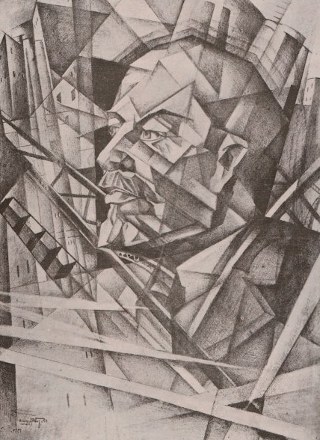
The concept of state capitalism is used in two senses here: on the one hand as a sector of a mixed market economy. On the other it is a term from formation theory denoting the economic method and arrangement for the transitional period and seen as a phase of it. It is a type of “state capitalism,” in quotes, that cannot be found in “any textbooks,” “nor in the writings of Marx and Engels”: “On the question of state capitalism … our press and our Party make the mistake of dropping into intellectualism, into liberalism; we philosophize about how state capitalism is to be interpreted, and look into old books. But… not a single book has been written about state capitalism under communism” (Speech at the Eleventh Congress of the R.C.P.(B.), LCW, Vol. 33, 277–278; Krausz 2007).
As early as in 1918, Lenin suggested that he used the term “state capitalism” for the relations of the transitional period. “State capitalism would be for us, and for Russia, a more favorable form than the existing one. … We did not overrate either the rudiments or the principles of socialist economy, although we had already accomplished the social revolution. On the contrary, at that time in 1918 we already realized to a certain extent that it would be better if we first arrived at state capitalism and only after that at socialism”(LCW, Vol. 33, 420). It is not accidental that it caused a great upheaval amongst Marxists, when – following Tony Cliff – the term of state capitalism was transferred to the description of state socialism, which was established after the Stalinist turn.5
The Theory of Socialism and Its Practical Possibilities
Lenin’s speech at the 11th Party Congress stressed in particular that during the NEP period Russia would develop in the framework of a multisectoral mixed economy, in which the various forms of economy compete, and mobilize different social forces: “When I spoke about communist competition, what I had in mind were not communist sympathies but the development of economic forms and social systems” (LCW, Vol. 33, 287). These various forms – small proprietors, the state capitalist, state socialist, and self-governing cooperative sectors – formed a system of market economy, which meant that the direct realization of socialism as a system was taken off the practical political agenda. In other words, the goal was the survival of socialism as a sector. Lenin’s theory of socialism is compatible with this coherent structure, in which each social-economic sector was composed of further subsectors and organizational forms of production and consumption. This multisectoral system came to a halt with the turn promoted by Stalin, which swept away the sectors of both market capitalist and direct communal forms of production. State socialism came into being in 1929–1933 as a system derived from well-known historical circumstances. Then people started to call it socialism as the 1936 Constitution declared it.
During the 1920s the special characteristic of direct communal ownership and production was realized either in the form of voluntary associations or by way of state mediation, though only in a small fraction of agricultural and industrial units or fields. Lenin focused much of his attention at the end of his life on “self-governing” and “cooperative socialism” – the historical possibilities of an economic system built on direct democracy – which he called “islands of socialism.” The significance of the experiments with cooperatives was of immense importance to Lenin, because “this political power owns all the means of production, the only task, indeed, that remains for us is to organize the population in cooperative societies. … Socialism … will achieve its aim automatically” (On Cooperation, LCW, Vol. 33, 467–475). Though the NEP had been “made to last,” Lenin never removed socialism from his agenda, even under circumstances of market restoration.
This was even though he knew that thinkers and politicians who had been nursed by the market and state looked down upon cooperatives, even “from the standpoint of transition to the new system by means that are the simplest, easiest and most acceptable to the peasant.” He knew that incorporating the whole population into voluntary cooperatives of production and consumption would take a longer historical period to realize – precisely because of the absence of the cultural-civilizatorial preconditions – and yet he insisted on posing this problem.6 The exact relationship between cooperatives and socialism that Lenin had in mind becomes clear in the light of his whole approach, the complete and coherent system of his thoughts.
The cooperatives, as he wrote, are the products of capitalism; they are “collective capitalist institutions” in which the future of socialism can be glimpsed. Producers have the opportunity to shape the cooperatives in their own image in the course of a revolutionary reform of state power, similarly to how in the NEP, “when we combine private capitalist enterprises … with enterprises of the consistently socialist type … the question arises about a third type of enterprise, the cooperatives, which were not formally regarded as an independent type differing fundamentally from the others.” He spoke about the possibility of coexisting state socialist and cooperative socialist enterprises, though a differentiation between the two forms of cooperative, state and self-governed, would soon come about (LCW, Vol. 33, 472–473). By the mid-1920s, nearly 10 million people had been pooled into state-organized and state-subsidized consumer cooperatives. Lenin marked out explicitly that a shift must be made from the interpretation of socialism previously reached (war communist, state powered, and politicized) to the position of “cooperative socialism.”
“Now we are entitled to say that for us the mere growth of cooperation … is identical with the growth of socialism, and at the same time we have to admit that there has been a radical modification in our whole outlook on socialism. The radical modification is this; formerly we placed, and had to place, the main emphasis on the political struggle, on revolution, on winning political power, etc. Now the emphasis is changing and shifting to peaceful, organizational, ‘cultural’ work. I should say that emphasis is shifting to educational work, were it not for our international relations, were it not for the fact that we have to fight for our position on a world scale” (LCW, Vol. 33, 474).
A direct replenishment of needs had the advantage of presenting internal needs and “potential output” that could be calculated in advance, without employing an office to do such work. The most comprehensive modern theory of socialism has been published by István Mészáros (2018), entitled Beyond Capital, who ties his work on capital to the theoretical fundamentals of Marx and Lenin, and links his concept of socialism not to the concepts of market production, but both looks for and defines these concepts beyond the market and the state – “beyond capital,” in short. After Stalin’s death, “dogmatics” and “revisionists” in each communist party made a compromise in order to retain power. Later, at the time of the change of regime the former “revisionists,” now as liberals, represented and formed the ideological mainstream of the market-capitalist restoration.7
Lenin’s theory of socialism and the main direction of his political activity was targeted at the gradual delinking from the “capital system.” In East European state socialism, instead of the renaissance of self-governing, cooperative socialism, it was the power of capital that came back with its semi-peripheral characteristics. Lenin’s ouvre, representing and working out specific historical experiences, remains actual until we realize socialism, since there has been no other relevant alternative to capitalism over the last centuries. There is “only” one question remaining: how do we evaluate current attempts, what kind of socialism would be viable in replacing capitalism and how to bring it about? Whether to promote the second or updated edition of state socialism – or to take the direction of self-governing socialism, the culture of workers’ councils, forms of cooperatives leading to the self-defense and self-organization of the working people. For me it is crystal clear that Lenin would certainly insist on the latter variant. •
Bibliography
- Krausz, Tamás 1996a: A szovjet thermidor [The soviet thermidor]. Budapest: Napvilág Kiadó.
- Krausz, Tamás 1996b: An ahistorical political economics. Reviewed work: Socialist Systems by János Kornai. Social Scientist 24, 1–3 ( January – March 1996), 111–127.
- Krausz, Tamás 2005: ‘Stalin’s Socialism’ – today’s debates on socialism: theory, history, politics. Contemporary Politics 11/4 (2005), 235–238.
- Krausz, Tamás 2007: A szocializmusvita jelenlegi állásáról [On the current position of the debate on socialism]. In: Krausz, Tamás – Szigeti, Péter (eds), Államszocializmus: Értelmezések – viták – tanulságok [State socialism: Interpretations – debates – lessons]. Budapest: L’Harmattan – Eszmélet Foundation, 122–144.
- Krausz, Tamás 2015: Reconstructing Lenin: An Intellectual Biography. New York: Montly Review Press.
- Krausz, Tamás 2017: Lenin e la rivoluzione d’Ottobre. Introduzione. In: Stato e rivoluzone. Edizione del centenario con un saggio introduttivo di Tamás Krausz su Lenin e la rivoluzione d’Ottobre. Trauzione di Lila Grieco. Roma: Piccola Biblioteca Donzelli, 7–64.
- Krausz, Tamás 2020: Lenin on global history and the global historiography on Lenin. RussianStudiesHu 2020.
- Krausz, Tamás – Szigeti, Péter (eds) 2007: Államszocializmus: Értelmezések – viták – tanulságok [State socialism: Interpretations – debates – lessons]. Budapest: L’Harmattan – Eszmélet Foundation.
- LCW = Lenin, V. I. 1960–1970: Collected Works. Moscow: Progress Publishers, Vols 1–45.
- Marx, Karl 1875/1972: Critique of the Gotha Programme. Beijing: Foreign Languages Press.
- Marx, Karl 1887: Capital. First English edition of 1887. 4th German edition changes included as indicated; with some modernisation of spelling. Moscow: Progress Publishers.
- Mészáros, István 2018: Beyond Capital. Toward a Theory of Transition. New York: Monthly Review Press.
This article first published on the LeftEast website.
Endnotes
- I used the following works in writing this paper: Krausz 1996a; 2005; 2007; 2015. In this short paper I cannot reflect on the huge and excellent literature on Lenin, I can only refer to some of it, e.g. Lars Lih, Paul LeBlanc, H. Tickin, V. Loginov, and Alternativi, the monthly from Moscow, and several other Marxist sources from all over the world. Due to constraints in length I do not discuss here the debates between Soviet leaders and other currents.
- About the importance of this small book, see Krausz 2017.
- The most important work of Marx that draws out the outlines of socialism, is the Critique on the Gotha Programme (Marx 1875/1972).
- It is worth noting that the notion of “consciousness” not only implies moral content but also knowledge itself, and understanding long-term interests.
- There is systematic critique of the state-capitalist interpretation of socialism in Hungary as well. See Krausz –Szigeti 2007.
- “The cooperatives must be granted state loans that are greater, if only by a little, than the loans we grant to private enterprises.” (The cooperative order as socialism.) “But it will take a whole historical epoch to get the entire population into the work of the cooperatives through NEP.” On Cooperation, LCW, Vol. 33, 469–70.
- See on this my review of Kornai: Krausz 1996b.


